 October 17, 2019 John E. Ross, KD8IDJ, Editor
| ||||||
ARRL to Launch New On the Air Magazine ARRL is launching a new magazine, On the Air, in January 2020. To be published on a bimonthly basis, On the Air will offer new and beginner-to-intermediate-level radio amateurs a fresh approach to exploring radio communication. Each issue will include advice and insights on topics from the variety of Amateur Radio interests and activities: radio technology, operating, equipment, project building, and emergency communication. The goal of this new magazine is to be a vital resource in helping new and newer radio amateurs get active and involved in radio communications.
"Too many new licensees never take the next step," says Schoenfeld. "We're excited to introduce a new Amateur Radio magazine for this audience, aimed at getting them active, getting them involved, and getting them on the air." The first issue of On the Air will be published in January 2020 (January/February issue) and will be introduced as a new ARRL membership benefit. Effective November 1, when eligible US radio amateurs join ARRL or renew their memberships, they will be prompted to select the print magazine of their choice -- On the Air or QST. Current members receiving the print edition of QST, upon renewal, may choose to continue receiving the print edition of QST (monthly) or the print edition of On the Air (bimonthly). All ARRL members, including international members, will be able to access digital editions of both QST and On the Air. Members who already access QST on the web or from the mobile app will be able to access QST and On the Air starting in January. ARRL Online Auction Bidding is Now Open Bidding began today, October 17, on more than 230 items on the block in the 14th annual ARRL Online Auction. Bidding got under way at 10 AM EST (1400 UTC), and the auction will continue through Thursday, October 24, closing at 10 PM EST (Friday, October 25, at 0200 UTC).
Among book offerings in the auction are the "sold out" 2019 Handbook Boxed Set, a special defense edition of The Radio Amateur's Handbook from 1942, and a 1949 ARRL Antenna Book. Proceeds from the annual Online Auction benefit ARRL education programs. Bidders must register (your arrl.org user ID and password will not work on the auction site). If you have registered for a previous ARRL Online Auction, you may use the same login information this year. Report Causes Concern and Confusion in California's Amateur Radio Ranks By all credible and reliable accounts, the State of California has not turned its back on Amateur Radio as an emergency communication resource, nor have established repeater owners been asked to remove their equipment from state-owned sites unless they pay sizable fees. The California controversy, inflamed by a viral YouTube video, stemmed from a California Department of Forestry and Fire Protection "I do understand and appreciate all of the service you have provided in the past," CAL FIRE's Lorina Pisi, told the unknown repeater owner(s) or group(s) last month. "However, with constantly changing technological advances, there is no longer the same benefit to State as previously provided. Therefore, the Department no longer financially supports HAM operators [sic] radios or tenancy. If you desire to enter into a formal agreement to operate and maintain said equipment, you must complete and submit attached collocation application along with fee as outlined on page one of application. There is cost associated with getting an agreement in place." It's not clear to whom Pisi's memo was addressed, because any name or names were redacted from the version of the memo that is being circulated. ARRL reached out to Pisi but has not heard back. ARRL officials who have also looked into the situation agree that it's been blown out of proportion by parties with their own agendas.
ARRL Southwestern Division Director Dick Norton, N6AA, has been responding to inquiries with the same message. Read more. NASA Spacecraft Launches on Mission to Explore Frontier of Space NASA's Ionospheric Connection Explorer (ICON) spacecraft is in orbit for a first-of-its-kind mission to study a region of space where changes can disrupt communications and satellite orbits, and even increase radiation risks to astronauts. ICON was launched on October 11 after a Stargazer L-1011 aircraft from Cape Canaveral Air Force Station in Florida carried it to about 39,000 feet. Then, a Pegasus rocket fired the roughly refrigerator-sized ICON into space.
The spacecraft's solar panels successfully deployed, indicating it has power with all systems operating, NASA reported. ICON will start sending back its first science data in November. ICON will study changes in the ionosphere, where, in addition to affecting radio signal propagation, space weather can prematurely decay spacecraft orbits and expose astronauts to radiation-borne health risks. "Historically, this critical region of near-Earth space has been difficult to observe," NASA explained. "Spacecraft can't travel through the low parts of the ionosphere and balloons can't travel high enough." ICON's orbit around Earth places it at a 27° inclination at an altitude of about 360 miles, from which it can observe the ionosphere around the equator. Nicola Fox, Director for Heliophysics at NASA Headquarters in Washington, said that ICON will be the first mission to simultaneously track what's happening in Earth's upper atmosphere and in space to see how the two interact, causing the kinds of changes that can disrupt radio communication. ICON will employ four instruments to explore the connections between the neutral atmosphere and the electrically charged ionosphere. Three of these rely on the phenomenon called airglow, which is created by a process similar to that which causes aurora -- gas is excited by radiation from the sun and emits light. By way of airglow, ICON can observe how particles throughout the upper atmosphere are moving. ICON's fourth instrument provides direct measurements of the ionosphere around it. Amateur Radio on the International Space Station (ARISS) veteran Will Marchant, KW4WZ (ex-KC6ROL), is part of the ICON team. So Now What? Podcast "Ham Lingo" will be the focus of the new (October 17) episode of the So Now What? podcast for Amateur Radio newcomers.
So Now What? is sponsored by LDG Electronics, a family owned and operated business with laboratories in southern Maryland that offers a wide array of antenna tuners and other Amateur Radio products. ARRL Communications Content Producer Michelle Patnode, W3MVP, and ARRL Station Manager Joe Carcia, NJ1Q, co-host the podcast. Presented as a lively conversation, with Patnode representing newer hams and Carcia the veteran operators, the podcast will explore questions that newer hams may have and the issues that keep participants from staying active in the hobby. Some episodes will feature guests to answer questions on specific topic areas. Listeners can find So Now What? on Apple iTunes, Blubrry, Stitcher (free registration required, or browse the site as a guest), and through the free Stitcher app for iOS, Kindle, or Android devices. Episodes will be archived on the ARRL website. Next School Club Roundup Set for October 21 - 25 ARRL's twice-yearly School Club Roundup (SCR) gets under way on Monday, October 21, at 1300 UTC, and runs through Friday, October 25, at 2359 UTC. Stations may operate for up to 24 hours during the entire contest and for 6 hours during any single 24-hour period. Any mode -- SSB, CW, or digital -- is allowed for the event. Stations will participate in five categories: Elementary/Primary, Middle/Intermediate/Junior High School, Senior High School, College/University Club, and Non-School Club. There is also a category for Individuals to participate.
The School Club Roundup is co-sponsored by ARRL and the Long Island Mobile Amateur Radio Club (LIMARC), and results appear in QST as well as online. The top three entries in each category -- Elementary, Middle/Intermediate/Junior High School, Senior High School College/University -- will receive an award certificate. Non-school clubs or multioperator groups and individuals are also eligible for certificates. Submit scores and logs via the SCR score entry website. Scores and logs may be entered from the time the contest begins through the log submission deadline. Paper logs are acceptable as well. Logs for the October SCR are due by November 9. The K7RA Solar Update Tad Cook, K7RA, Seattle, reports: Solar activity remains very low. At the bottom of the sunspot cycle, any sunspot activity is fleeting. Another week has passed with no sunspots at all. Spaceweather.com reports no sunspots for the past 2 weeks, and the total number of spotless days this year is now 213, or 73%, which matches the percentage of spotless days in 2008 -- 11 years ago. Average daily solar flux during the week of October 10 - 16 was 67.3, down insignificantly from 67.6 during the previous week.
The predicted solar flux for the next 45 days is 68, through the end of November. Predicted planetary A index is 5 on October 17 - 20; 12, 8, 5, 18, 25, 12, 10, and 8 on October 21 - 28; 5 on October 29 - November 9; 8 on November 10 - 11; 5 on November 12 - 16; 15 on November 17; 5 on November 18 - 19; 15, 20, 10 and 8, on November 20 - 23, and 5 on November 24 - 30. Rick Tucker, W0RT, of Parsons, Kansas, was listening for HZ1TT (Saudi Arabia) on October 14 on 21.023 MHz at 1045 UTC. The band sounded dead, but at 1115 UTC he copied several European stations calling and working the Saudi station. Tucker said he never heard HZ1TT, but HZ1TT was spotted by a station in New Brunswick, Canada. Sunspot numbers for October 10 - 16 were 0, 0, 0, 0, 0, 0, and 0, with a mean of 3.1. The 10.7-centimeter flux was 67.5, 68.5, 68.3, 67.2, 66.2, 67.2, and 66.3, with a mean of 67.3. Estimated planetary A indices were 13, 8, 5, 2, 6, 5, and 6, with a mean of 6.4. Middle latitude A index was 10, 6, 4, 1, 5, 5, and 5, with a mean of 5.1. A comprehensive K7RA Solar Update is posted Fridays on the ARRL website. For more information concerning radio propagation, visit the ARRL Technical Information Service, read "What the Numbers Mean...," and check out K9LA's Propagation Page. A propagation bulletin archive is available. Monthly charts offer propagation projections between the US and a dozen DX locations. Share your reports and observations. Just Ahead in Radiosport
See the ARRL Contest Calendar for more information. For in-depth reporting on Amateur Radio contesting, subscribe to The ARRL Contest Update via your ARRL member profile email preferences. PACTOR Developer SCS Announces Monitoring Software SCS, the company that created PACTOR, has unveiled software that offers the ability to monitor the content of PACTOR 1, 2, and 3 transmissions over the air. The free PMON software runs under the Linux operating system. A software version to monitor PACTOR 4 is scheduled to become available next year. PMON will offer "thorough observation and documentation of all presently available PACTOR 1, 2, and 3 transmissions," SCS said.
According to SCS, only minimal hardware is required to use PMON. The equipment complement includes a Raspberry Pi 3 Model B+ (minimum) computer and a USB sound device. SCS noted in an October 11 news release that all SCS PACTOR hardware modems include a command to allow PACTOR monitoring on the fly. The German company says PMON now makes this possible without a modem and adds the ability to decode B2F/LZHUF-compressed messages -- Winlink email and others. "This exciting new software development for Raspberry Pi complements and surpasses previously released SCS software that leveraged PACTOR modems' ability to monitor PACTOR to read Winlink for meaning," SCS said. The company also said the new software permits modem-less monitoring of all kinds, something that would be useful for monitoring Winlink email traffic. The Winlink Development Team called the new software a "welcome contribution to the Amateur Radio community." The issue of message encryption arose in recent months with respect to renewed attention to ARRL's so-called "symbol rate" petition for rulemaking (RM-11708) and the accommodation of automatically controlled digital stations (ACDS) -- many of which employ Winlink. Some commenters on ARRL's petition have asserted incorrectly that PACTOR facilitates de facto message encryption, which would violate FCC Amateur Service rules. AMSAT Goal: "Amateur Radio in Every CubeSat" AMSAT wants to see Amateur Radio in every CubeSat, and it's partnering with non-Amateur Radio partners to make that happen. In
Stoetzer said CubeSat programs interested in launching an Amateur Radio payload may partner with AMSAT to carry a Fox-1E module on their spacecraft. "By providing Amateur Radio capability, the CubeSat program gets a worldwide ground station network to receive their telemetry and experiment data while the Amateur Radio community gets a transponder to use in orbit," he pointed out. Stoetzer said the first such partnership will be with the Husky Satellite Lab at the University of Washington. Its 3U CubeSat -- HuskySat-1 -- is set to launch on the ELaNa XXV mission from Wallops Island, Virginia, no sooner than November 2. A Northrop Grumman Cygnus spacecraft will carry HuskySat-1 to the International Space Station, and after completing its mission there, Cygnus will continue to an orbit of approximately 500 kilometers (310 miles) to deploy HuskySat-1.
AMSAT will celebrate its 50th anniversary at its 2019 Board of Directors meeting and AMSAT Space Symposium October 18 - 20 in Arlington, Virginia. -- Thanks to AMSAT News Service Homebrew Heroes Award for 2019 in Amateur Radio Announced The Homebrew Heroes Award Program has announced its first annual recipient. He is Hans Summers, G0UPL, of East Sussex in the UK. The annual award recognizes individuals, groups, or organizations who help define the frontiers of Amateur Radio technology through the long-standing tradition of constructing their own equipment.
"Our Steering Committee sought the advice of an anonymous selection committee that surveyed the landscape of known homebrew designers in Amateur Radio," Steering Committee member Frank Howell, K4FMH, said in an October 13th news release. "There are indeed many very deserving ones! But only one can be chosen each year." Other Steering Committee members are Martin Butler, M1MRB, and Colin Butler, M6BOY -- all affiliated with the ICQ Podcast. For his part, Summers said he was humbled and "just blown away by it all" to be the first recognized with the Homebrew Heroes Award. Summers said he's been sharing his homebrew work and that of his company QRP Labs through his website for years. "To have these efforts publicly recognized in this way is so personally gratifying," Summers said. Martin Butler said that Summers "has continually demonstrated to all with at least one eye open that the traditional homebrew craft and science is alive and well." "I've watched Hans Summers continue to innovate in his design of terrific homebrew kits and products that have made a fantastic impact on the Amateur Radio marketplace," Colin Butler added. "As publisher of the ICQ Podcast, I am delighted for us to serve as the official promotional partner of this awards program." Read more. In Brief...
Upcoming ARRL Section, State, and Division Conventions
Find conventions and hamfests in your area
. .
Subscribe to...
Free of charge to ARRL members...
| ||||||
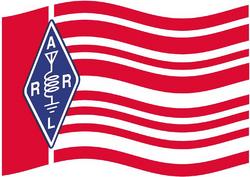 "On the Air responds to the brand-new and not-so-brand-new radio amateur seeking ideas and answers," said QST Managing Editor Becky Schoenfeld, W1BXY. Schoenfeld is part of the ARRL staff team that developed the new magazine. The planning included an extensive national-level study of new Amateur Radio licensees, identifying their motivations for getting licensed and their experiences of getting started. A focus group responded positively to a trial sample edition of the magazine.
"On the Air responds to the brand-new and not-so-brand-new radio amateur seeking ideas and answers," said QST Managing Editor Becky Schoenfeld, W1BXY. Schoenfeld is part of the ARRL staff team that developed the new magazine. The planning included an extensive national-level study of new Amateur Radio licensees, identifying their motivations for getting licensed and their experiences of getting started. A focus group responded positively to a trial sample edition of the magazine. The 2019 auction includes lab-tested QST "Product Review" gear, vintage books, used equipment, and one-of-a-kind items. Some premier "Product Review" items up for bid include the Elecraft KPA1500 legal-limit HF and 6-meter linear amplifier, the Icom IC-7610 HF and 6-meter transceiver, the Palstar LA-1K 160 - 6 meter amplifier, the FlexRadio Systems FLEX-6400M HF and 6-meter SDR transceiver, and the Kenwood TS-890 HF and 6-meter transceiver.
The 2019 auction includes lab-tested QST "Product Review" gear, vintage books, used equipment, and one-of-a-kind items. Some premier "Product Review" items up for bid include the Elecraft KPA1500 legal-limit HF and 6-meter linear amplifier, the Icom IC-7610 HF and 6-meter transceiver, the Palstar LA-1K 160 - 6 meter amplifier, the FlexRadio Systems FLEX-6400M HF and 6-meter SDR transceiver, and the Kenwood TS-890 HF and 6-meter transceiver. (CAL FIRE) communication telling a repeater owner or group that Amateur Radio equipment would have to be removed from a state-owned site or "vault" if the owner(s) determined the cost was too great to proceed with a formal application to keep it there.
(CAL FIRE) communication telling a repeater owner or group that Amateur Radio equipment would have to be removed from a state-owned site or "vault" if the owner(s) determined the cost was too great to proceed with a formal application to keep it there. "The State of California has not made any determination we can find 'that Ham Radio [is] no longer a benefit,'" Pacific Division Director Jim Tiemstra, K6JAT, is quoted on the
"The State of California has not made any determination we can find 'that Ham Radio [is] no longer a benefit,'" Pacific Division Director Jim Tiemstra, K6JAT, is quoted on the  If you're a newly licensed Amateur Radio operator, chances are you have lots of questions. This biweekly podcast has answers! So Now What? offers insights from those who've been just where you are now. New episodes will be posted every other Thursday, alternating new-episode weeks with the
If you're a newly licensed Amateur Radio operator, chances are you have lots of questions. This biweekly podcast has answers! So Now What? offers insights from those who've been just where you are now. New episodes will be posted every other Thursday, alternating new-episode weeks with the 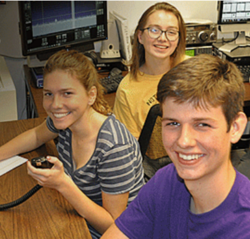 The most popular time for younger students to be on the air is during after-school hours, but older students may be on the air at any time. Groups are limited to one transmitter on the air at any given time. Stations exchange signal report, category (School, Club, or Individual), and state, province, or DXCC entity. Stations can be worked once per band and mode. Participants will now be able to make up to three contacts with a station on each band using CW, voice, and digital modes.
The most popular time for younger students to be on the air is during after-school hours, but older students may be on the air at any time. Groups are limited to one transmitter on the air at any given time. Stations exchange signal report, category (School, Club, or Individual), and state, province, or DXCC entity. Stations can be worked once per band and mode. Participants will now be able to make up to three contacts with a station on each band using CW, voice, and digital modes. The average daily planetary A index was 6.4, down from 14.4 over the previous week, and the average daily mid-latitude A index declined from 11 to 5.1.
The average daily planetary A index was 6.4, down from 14.4 over the previous week, and the average daily mid-latitude A index declined from 11 to 5.1. "PMON covers all PACTOR levels with the appropriate speed levels and packet variations," SCS said. "PMON will read in parallel PACTOR 2 and PACTOR 1. The very wide receiving range (frequency offset ±200 Hz), as well as automatic sideband recognition, ease routine operation of PMON with PACTOR 2 and PACTOR 3 considerably."
"PMON covers all PACTOR levels with the appropriate speed levels and packet variations," SCS said. "PMON will read in parallel PACTOR 2 and PACTOR 1. The very wide receiving range (frequency offset ±200 Hz), as well as automatic sideband recognition, ease routine operation of PMON with PACTOR 2 and PACTOR 3 considerably."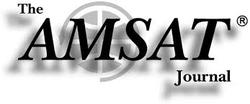 the "Apogee View" editorial for the September/October issue of The AMSAT Journal, Executive Vice President Paul Stoetzer, N8HM, wrote, "[W]e continue to support a stream of LEO satellites. RadFxSat-2/Fox-1E is ready for launch no earlier than December 1, 2019, on the ELaNa XX mission. The linear transponder and telemetry system carried aboard Fox-1E was designed for use in different CubeSats by merely adding an interface adapter for connection to the host bus."
the "Apogee View" editorial for the September/October issue of The AMSAT Journal, Executive Vice President Paul Stoetzer, N8HM, wrote, "[W]e continue to support a stream of LEO satellites. RadFxSat-2/Fox-1E is ready for launch no earlier than December 1, 2019, on the ELaNa XX mission. The linear transponder and telemetry system carried aboard Fox-1E was designed for use in different CubeSats by merely adding an interface adapter for connection to the host bus."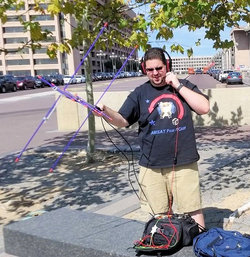
 "After a 30-day mission to complete tests of its experimental payloads -- a pulsed plasma thruster, and a K-band (24 GHz) communications system -- the satellite will be turned over to AMSAT, and the linear transponder will be made available to the Amateur Radio community," Stoetzer said.
"After a 30-day mission to complete tests of its experimental payloads -- a pulsed plasma thruster, and a K-band (24 GHz) communications system -- the satellite will be turned over to AMSAT, and the linear transponder will be made available to the Amateur Radio community," Stoetzer said.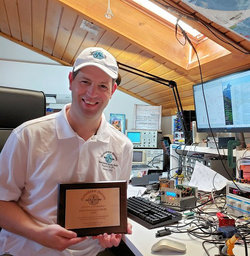
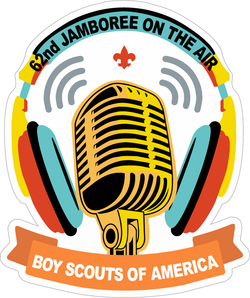 Scouting's Jamboree on the Air (
Scouting's Jamboree on the Air (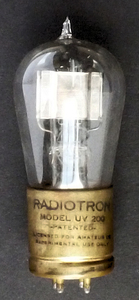 The legendary Radio Corporation of America (RCA) incorporated on this date, October 17, in 1919. RCA negotiated patent cross-licensing agreements with other industry leaders, paving the way for the explosive development of American radio in the early 1920s. In 1921, WCC in Chatham, Massachusetts, became the first RCA coastal station equipped with tube sets offering 2 kW on 600 and 2200 meters. The WCC Amateur Radio Association (
The legendary Radio Corporation of America (RCA) incorporated on this date, October 17, in 1919. RCA negotiated patent cross-licensing agreements with other industry leaders, paving the way for the explosive development of American radio in the early 1920s. In 1921, WCC in Chatham, Massachusetts, became the first RCA coastal station equipped with tube sets offering 2 kW on 600 and 2200 meters. The WCC Amateur Radio Association (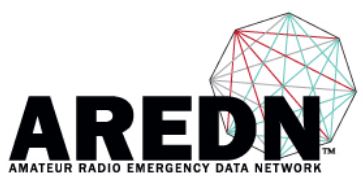 Two separate groups took advantage of the Amateur Radio Emergency Data Network (
Two separate groups took advantage of the Amateur Radio Emergency Data Network (.jpg) A mail delivery problem has affected delivery of West Gulf Division Board election ballots. Recent flooding has affected some US Postal Service distribution centers in the Houston area, damaging some sorting machines. This is delaying delivery to many members in that area. They are processing mail, but there are delays in processing bulk mail, which include the ballots. If you still do not receive your ballot by Monday, October 21, 2019, please
A mail delivery problem has affected delivery of West Gulf Division Board election ballots. Recent flooding has affected some US Postal Service distribution centers in the Houston area, damaging some sorting machines. This is delaying delivery to many members in that area. They are processing mail, but there are delays in processing bulk mail, which include the ballots. If you still do not receive your ballot by Monday, October 21, 2019, please 







